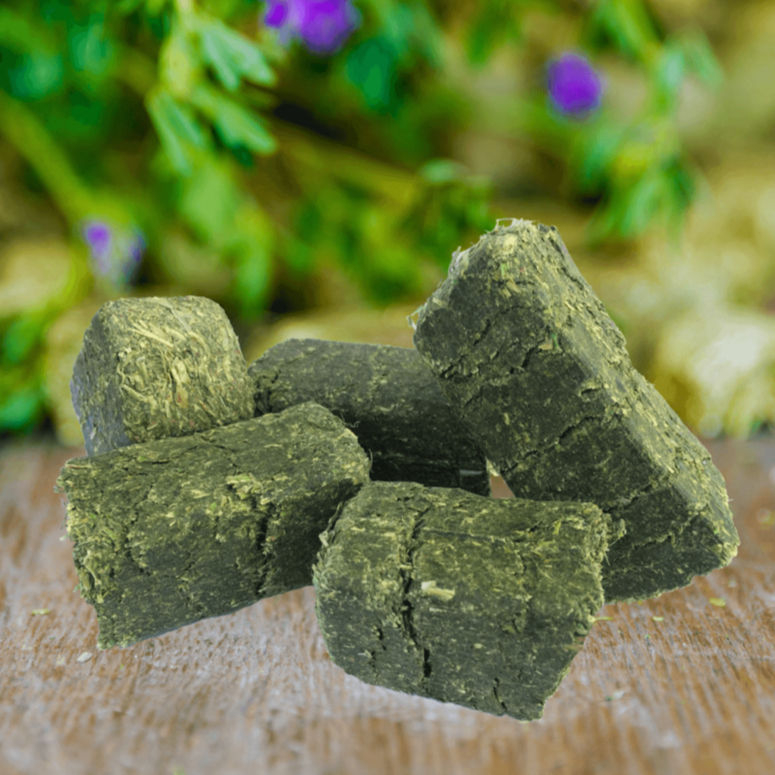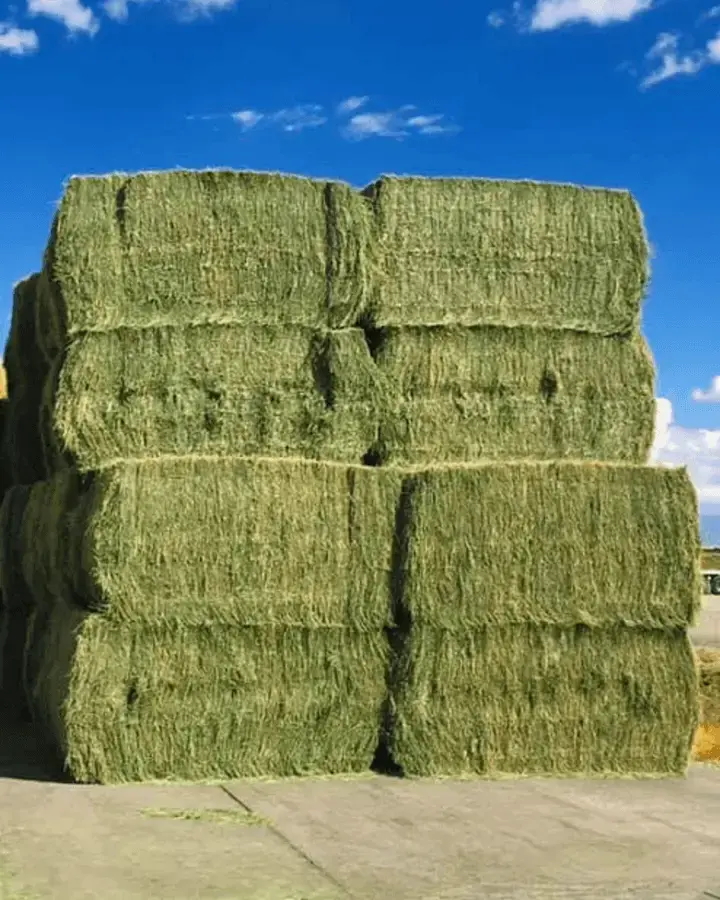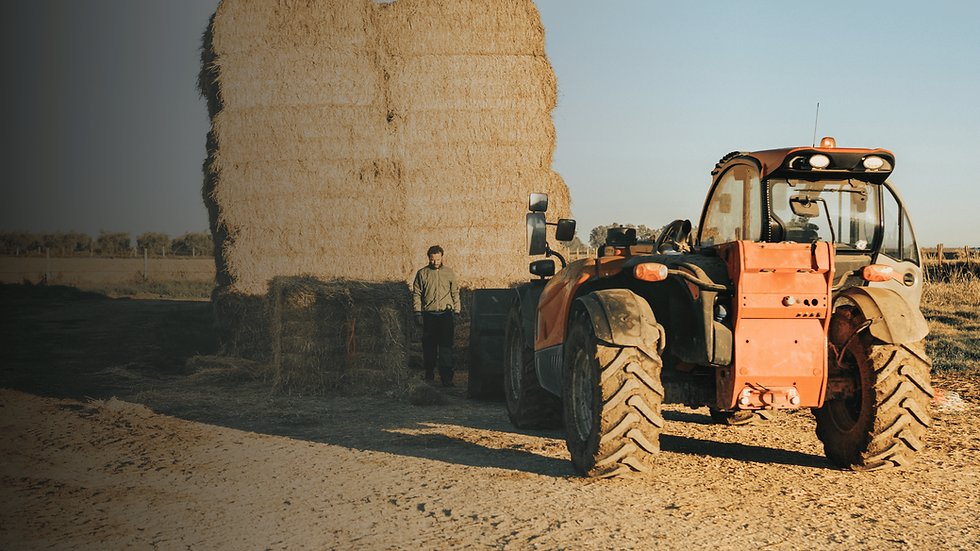Why Cubes of Hay Make Good Livestock Feed
- McKenna Hines
- Sep 2
- 8 min read

Introduction to Cubes of Hay
Cubes of hay are a compressed form of traditional forage, made by chopping and compressing dried hay into dense, easy-to-handle blocks.
For many livestock owners, these cubes offer a modern, efficient way to deliver high-quality nutrition. One reason cubes of hay are growing in popularity is their consistent quality and ease of use.
Because cubes of hay are usually produced from premium alfalfa, timothy, or mixed grass varieties, they provide a concentrated source of fiber and energy. These cubes also reduce the amount of dust typically associated with loose hay, making them suitable for animals with respiratory sensitivities.
Cubes of hay are especially appealing to farmers with limited storage space or those who require a tidy feeding environment. The compact design reduces waste and mess compared to traditional hay flakes.
Understanding how cubes of hay compare to bales or pellets helps livestock owners make informed feed decisions. Their uniform shape and density ensure each animal gets a consistent ration of nutrients in every serving.
Whether you're feeding horses, goats, cows, or sheep, cubes of hay are a versatile option that fits into nearly any feeding program while minimizing waste and maximizing nutrition.
Nutritional Consistency and Quality Control
One of the biggest advantages of feeding cubes of hay is the guaranteed consistency in nutritional value. Unlike loose hay, which can vary significantly between bales, cubes of hay are blended and processed to meet specific nutrient standards.

Each batch of cubes of hay is often tested for protein, fiber, and mineral content, helping farmers better control what their animals consume.
This is particularly helpful for animals with special dietary needs or those in breeding or lactating stages.
With cubes of hay, livestock receive predictable levels of protein and energy, which supports more accurate rationing and avoids imbalances.
The pellets are often free of weeds or unwanted plant matter commonly found in loose bales.
For livestock producers trying to optimize health and performance, cubes of hay offer the reliability needed for consistent results. They're especially valuable during seasonal forage transitions or drought periods when hay quality varies widely.
By incorporating cubes of hay into the feeding routine, ranchers can reduce the guesswork involved in nutrition planning, leading to healthier animals and improved productivity across the board.
Storage and Space Efficiency
For many small and mid-sized farms, limited storage space is a constant concern. Traditional hay bales take up significant room and must be kept dry to prevent mold. Cubes of hay solve this problem with compact, stackable packaging that saves time and space.
Because cubes of hay are dense and uniform, they require significantly less space than round or square bales. This is ideal for operations with limited barn capacity or indoor feeding stations. Redmond offers some good additional insights into good hay storage practices in this article.
In addition to taking up less space, cubes of hay are easier to transport. Whether you're hauling them in a pickup bed or wheelbarrow, you’ll move more feed with less effort. This is especially helpful for mobile or pasture-based livestock systems.
Moisture resistance is another storage perk. Many cubes of hay are shrink-wrapped or bagged in protective materials, guarding against humidity and spoilage when stored properly.
If your operation is seeking a cleaner, more organized way to store forage, cubes of hay provide a practical and cost-effective solution that also enhances feeding logistics.
Ideal for Measured Feeding
Feeding accuracy is a major priority for those managing livestock health or weight gain. Cubes of hay make it easier to portion exact amounts compared to loose flakes or random-sized bales.

Because cubes of hay are uniform in size and weight, they allow for easy measuring using a scale or scoop. This helps ensure each animal gets the right amount of fiber and energy per meal.
Overfeeding and underfeeding are common issues when estimating by sight, especially with traditional hay. Cubes eliminate that uncertainty and promote better control of daily intake.
This is especially useful when managing young, senior, or performance animals who need specialized feeding plans.
A few extra pounds of hay might not matter to a cow, but it could impact a smaller goat or lamb.
With cubes of hay, livestock managers gain more control over nutrition delivery, leading to healthier animals and reduced feed waste over time.
Reduced Forage Waste and Mess
Traditional baled hay can lead to significant forage waste due to trampling, wind, or refusal. Cubes of hay minimize this issue by staying contained and uniform, resulting in cleaner feed areas.
When livestock consume cubes of hay, they’re less likely to scatter or waste it. Unlike loose hay that gets tossed and left uneaten, the dense format encourages full consumption.
Cubes of hay can also be served in tubs, buckets, or specialized feeders, further reducing ground mess and contamination from manure or moisture.
This efficiency translates into long-term savings. Farmers who switch to cubes of hay often report using less feed overall because there's virtually no spillage or spoilage.
For operations where cleanliness and conservation are top priorities, cubes of hay provide a sustainable and waste-reducing alternative to traditional forages.
Perfect for Travel and On-the-Go Feeding
For livestock owners who transport animals to shows, auctions, breeding centers, or rotational pastures, cubes of hay offer unmatched convenience.
Since cubes of hay are compact and lightweight, they’re easier to load into trailers, bags, or bins. This makes feeding on the road less stressful and more consistent.
Unlike loose hay, which breaks apart and becomes messy, cubes maintain their shape and are easy to ration in mobile setups.
Whether you're managing horses at a competition or taking goats to a fair, cubes of hay simplify feeding routines while keeping animals fueled and calm.
Consistent nutrition during travel reduces the risk of digestive upset, and using cubes of hay allows owners to bring a familiar feed along no matter where they go.
Ideal for Soaking and Senior Animal Feeding
Older animals often struggle with dental issues or dehydration, making traditional hay harder to chew and digest. That’s where cubes of hay truly shine—they can be soaked into a soft mash.

Soaked cubes of hay create a palatable, moist feed that’s easy on aging teeth and supportive of gut health. Many senior livestock thrive on this soft, nutrient-rich alternative.
Livestock owners can soak cubes of hay in warm water for 15–30 minutes to create a mash that’s easier to chew and less likely to cause choke or colic.
For recovering animals or those on restricted forage diets, cubes of hay provide a reliable way to deliver calories and hydration simultaneously.
The ability to modify cubes of hay for different life stages makes them a smart, adaptable choice for long-term livestock care.
Easy Integration into Mixed Rations
Cubes of hay can be easily mixed with grain, supplements, or molasses to create custom rations. This adaptability makes them a favorite among ranchers and feedlot operators.
Whether you’re feeding a herd of dairy goats or a few backyard cattle, integrating cubes of hay with your existing ration is simple and scalable.
You can weigh, soak, or crumble cubes of hay into grain-based feed for more consistent fiber intake and better gut motility.
This feeding strategy ensures animals receive both energy and roughage without needing multiple feeding steps, especially during winter or breeding season.
The ability to blend cubes of hay into tailored diets helps balance nutrition, improve efficiency, and promote animal health across multiple species.
Great for All Livestock Types
Whether you're raising goats, cattle, sheep, horses, or alpacas, cubes of hay are a versatile feed option that works across species.

Because cubes of hay are made from quality forage like alfalfa or timothy, they deliver the same nutritional benefits expected from traditional hay—just in a more manageable form.
Different animals may have different protein or fiber needs, but cubes of hay can be chosen in blends or types to meet those specific demands.
Farmers who keep mixed herds appreciate the convenience of using a single feed format that can be adjusted per animal with soaking or supplements.
Choosing cubes of hay allows producers to simplify feed routines while still delivering species-specific nutrition on a consistent, reliable schedule.
Minimal Dust and Respiratory Risk
Traditional hay can be dusty and mold-prone, increasing the risk of respiratory issues like heaves in horses or chronic coughs in other livestock. Cubes of hay largely eliminate this concern.
Since cubes of hay are processed from pre-cut and screened forage, they contain far less airborne dust and mold spores.
This makes them ideal for animals with sensitivities, allergies, or recovering from respiratory infections.
You can further reduce dust by soaking cubes of hay for just a few minutes before feeding—especially helpful during dry seasons or barn confinement.
If you want to protect your herd’s lung health while maintaining forage quality, switching to cubes of hay is a smart move.
Easy to Store, Stack, and Distribute
One of the most appealing aspects of using cubes of hay is how simple they are to store and manage, especially for farms working in tight spaces.
Unlike large bales that require mechanical handling, cubes of hay can be stacked by hand and moved with minimal effort.
Their square or rectangular shape allows for vertical stacking and better utilization of feed rooms or barns, even in small operations.
Distributing cubes of hay is also faster. You can easily portion them into buckets or distribute them by weight using scales or visual markers.
This ease of handling saves time and labor while still providing consistent, high-quality nutrition to your animals daily.
Weather-Resistant and Easy to Protect
Cubes of hay come with a built-in advantage when it comes to storage durability. Because of their density and processing, they’re far less vulnerable to humidity and external weather changes.

If you’ve ever lost hay bales to moisture, rodents, or mold, cubes of hay offer a more resilient alternative. Their compressed form keeps the interior dry and stable when stored properly.
Plastic-wrapped or bagged cubes add even more protection from rain, snow, and temperature fluctuations, especially in uninsulated barns.
They’re also easier to seal and keep away from pests compared to loose hay, which invites messes and contamination.
By choosing cubes of hay, you’ll reduce spoilage and protect your feed investment year-round.
Cost-Effective for Long-Term Feeding
Feeding costs can add up quickly, especially when hay is scarce or prices spike due to droughts or supply chain issues. Cubes of hay offer a cost-effective solution without sacrificing quality.
Because you waste less and measure feed more precisely, cubes of hay often stretch further than loose hay. This leads to fewer refill trips and better budget control.
They also reduce labor costs, since loading, measuring, and distributing are easier. For large operations, these time savings matter.
Plus, some feed suppliers offer bulk discounts on cubes of hay, making them competitive with or even cheaper than traditional hay per pound of digestible fiber.
In the long run, cubes of hay make financial sense for farms looking to balance value with nutritional performance.
Encourages Healthy Digestion
Digestive health is a cornerstone of livestock care, and the high-fiber content in cubes of hay promotes healthy gut function across species.

Whether fed dry or soaked, cubes of hay provide the roughage needed to stimulate chewing and saliva production—both of which aid digestion.
Cubes of hay move steadily through the GI tract, reducing the risk of colic, bloating, or acidosis when managed properly.
Feeding smaller, more frequent meals of cubes of hay helps maintain steady gut motility, which is essential for ruminants and horses alike.
For livestock prone to digestive issues, switching to cubes of hay may improve outcomes and enhance nutrient absorption.
Sustainable and Environmentally Friendly
Sustainability is increasingly important in agriculture, and cubes of hay support that goal through reduced waste, packaging efficiency, and cleaner feeding.
They’re often produced from local hay farms using minimal processing and no additives, reducing the carbon footprint compared to grain-based feeds.
Because cubes of hay generate little to no waste, there’s less cleanup and fewer nutrients lost to runoff or contamination.
Packaging for cubes of hay is often recyclable or reusable, further cutting down on environmental impact.
When you choose cubes of hay, you’re not just investing in your animals—you’re also supporting a cleaner, more sustainable way to feed your farm.
Choose the Smarter Forage Option
Cubes of hay have earned their place as a smart, reliable option for feeding livestock. From consistent nutrition and low waste to convenient storage and species versatility, they offer benefits traditional hay often can’t match.

Whether you run a backyard hobby farm or a full-scale operation, cubes of hay provide practical advantages without sacrificing animal health.
Ready to upgrade your livestock’s diet? Rockin Rafter Ranch offers clean, nutrient-rich cubes of hay grown locally in Utah and available to ship statewide. Shop Cubes of Hay Now on our site!
Choose RR Ranch for livestock feed that’s fresh, reliable, and made with care from farm to feeder.


Comments